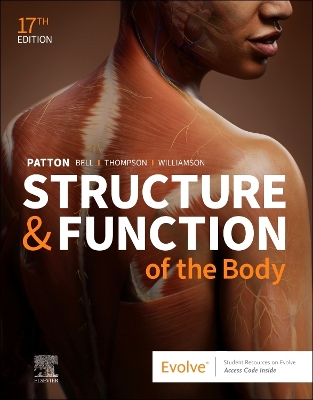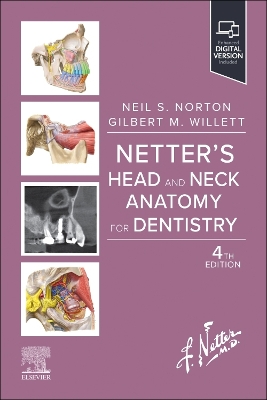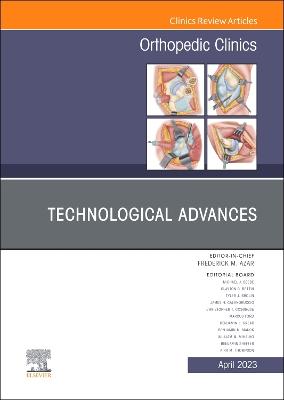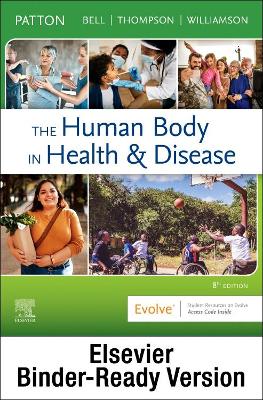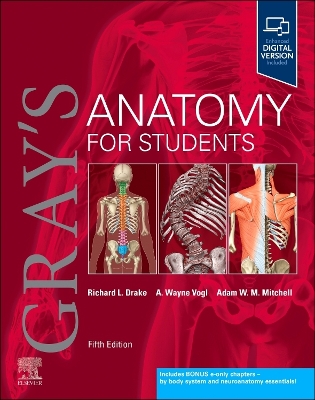Netter Collection of Medical Illustrations: Musculoskeletal System, Volume 6, Part I - Upper Limb
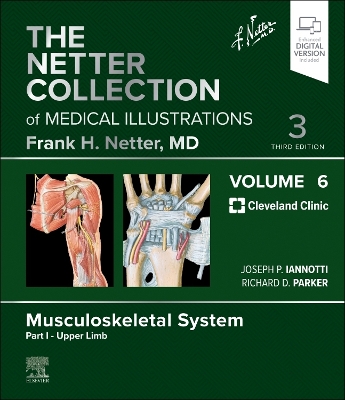 -10%
portes grátis
-10%
portes grátis
Netter Collection of Medical Illustrations: Musculoskeletal System, Volume 6, Part I - Upper Limb
Parker, Richard; Mroz, Tom; Abelson, Abby; Patterson, Brendan; Iannotti, Joseph
Elsevier - Health Sciences Division
05/2024
248
Dura
9780323880886
15 a 20 dias
Anatomy
1.1 Scapula and Humerus: Posterior View
1.2 Scapula and Humerus: Anterior View
1.3 Clavicle
1.4 Ligaments
1.5 Glenohumeral Arthroscopic Anatomy
1.6 Glenohumeral Arthroscopic Anatomy (Continued)
1.7 Anterior Muscles
1.8 Anterior Muscles: Cross Section
1.9 Posterior Muscles
1.10 Posterior Muscles: Cross Section
1.11 Muscles of Rotator Cuff
1.12 Muscles of Rotator Cuff: Cross Sections
1.13 Axilla Dissection: Anterior View
1.14 Axilla: Posterior Wall and Cord
1.15 Deep Neurovascular Structures and Intervals
1.16 Axillary and Brachial Arteries
1.17 Axillary Artery and Anastomoses Around Scapula
1.18 Brachial Plexus
1.19 Peripheral Nerves: Dermatomes
1.20 Peripheral Nerves: Sensory Distribution and Neuropathy in Shoulder
Clinical Problems and Correlations
Fractures and Dislocation
1.21 Proximal Humeral Fractures: Neer Classification
1.22 Proximal Humeral Fractures: Two-Part Tuberosity Fracture
1.23 Proximal Humeral Fractures: Two Part Surgical Neck Fracture and Humeral Head Dislocation
1.24 Proximal Humeral Fractures: Valgus-Impacted Four-Part Fracture
1.25 Proximal Humeral Fractures: Displaced Four-Part Fractures with Articular Head Fracture
1.26 Proximal Humeral Fractures: Reverse Total Shoulder Replacement
1.27 Anterior Dislocation of Glenohumeral Joint: Anterior Dislocation Types and Stimson Maneuver
1.28 Anterior Dislocation of Glenohumeral Joint: Pathologic Lesions
1.29 Anterior Dislocation of Glenohumeral Joint: Imaging
1.30 Posterior Dislocation of Glenohumeral Joint
1.31 Posterior Dislocation of Glenohumeral Joint (Continued)
1.32 Acromioclavicular and Sternoclavicular Dislocation
1.33 Fractures of the Clavicle
1.34 Fractures of the Clavicle and Scapula
Common Soft Tissue Disorders
1.35 Calcific Tendonitis
1.36 Frozen Shoulder: Clinical Presentation
1.37 Frozen Shoulder: Risk Factors and Diagnostic Tests
1.38 Biceps, Tendon Tears, and SLAP Lesions: Presentation and Physical Examination
1.39 Biceps, Tendon Tears, and SLAP Lesions: Types of Tears
1.40 Acromioclavicular Joint Arthritis
1.41 Impingement Syndrome and the Rotator Cuff: Presentation and Diagnosis
1.42 Impingement Syndrome and the Rotator Cuff: Radiologic and Arthroscopic Imaging
1.43 Rotator Cuff Tears: Physical Examination
1.44 Supraspinatus and Infraspinatus Rotator Cuff Tears: Imaging
1.45 Supraspinatus and Infraspinatus Rotator Cuff Tears: Surgical Management
1.46 Supraspinatus and Infraspinatus Cuff Tear: Surgical Management Superior Capsular Reconstruction and Balloon Arthroplasty
1.47 Supraspinatus and Infraspinatus Cuff Tear: Surgical Management Latissimus and Trapezius Transfers
1.48 Management of Subscapularis Rotator Cuff Tears
1.49 Management of Irreparable Subscapularis Tears: Pectoralis and Latissimus Transfers
1.50 Osteoarthritis of the Glenohumeral Joint
1.51 Osteoarthritis of the Glenohumeral Joint: Surgical Imaging
1.52 Avascular Necrosis of the Humeral Head
1.53 Rheumatoid Arthritis of the Glenohumeral Joint: Radiographic Presentations and Treatment Options
1.54 Rheumatoid Arthritis of the Glenohumeral Joint: Conservative Humeral Head Surface Replacement
1.55 Rotator Cuff-Deficient Arthritis (Rotator Cuff Tear Arthropathy): Physical Findings and Appearance
1.56 Rotator Cuff-Deficient Arthritis (Rotator Cuff Tear Arthropathy): Radiographic Findings
1.57 Rotator Cuff-Deficient Arthritis (Rotator Cuff Tear Arthropathy): Radiographic Findings (Continued)
1.58 Neurologic Conditions of the Shoulder: Suprascapular Nerve
1.59 Neurologic Conditions of the Shoulder: Long Thoracic and Spinal Accessory Nerves
Amputation
1.60 Amputation of Upper Arm and Shoulder, 61
Injections, Basic Rehabilitation, and Surgical Approaches
1.61 Shoulder Injections
1.62 Basic, Passive, and Active-Assisted Range of Motion Exercises
1.63 Basic Shoulder-Strengthening Exercises
1.64 Basic Shoulder Strengthening Exercises (Continued)
1.65 Common Surgical Approaches to the Shoulder
SECTION 2?UPPER ARM AND ELBOW
Anatomy
2.1 Topographic Anatomy
2.2 Anterior and Posterior Views of Humerus
2.3 Elbow Joint: Bones
2.4 Elbow Joint: Radiographs
2.5 Elbow Ligaments: Anterior Views
2.6 Elbow Ligaments: Lateral and Medial Views
2.7 Muscles Origins and Insertions
2.8 Muscles: Anterior Views
2.9 Muscles: Posterior Views
2.10 Cross Sectional Anatomy of Upper Arm
2.11 Cross Sectional Anatomy of Elbow
2.12 Cutaneous Nerves and Superficial Veins
2.13 Cutaneous Innervation
2.14 Musculocutaneous Nerve of Upper Arm and Elbow
2.15 Radial Nerve
2.16 Brachial Artery In Situ
2.17 Brachial Artery and Anastomoses around Elbow
Clinical Problems and Correlations
2.18 Physical Examination and Range of Motion
Fractures and Dislocation
2.19 Humeral Shaft Fractures
2.20 Injury to the Elbow
2.21 Fracture of Distal Humerus
2.22 Fracture of Distal Humerus: Total Elbow Arthroplasty
2.23 Fracture of Distal Humerus: Capitellum
2.24 Fracture of Head and Neck of Radius
2.25 Fracture of Head and Neck of Radius: Imaging
2.26 Fracture of Olecranon
2.27 Dislocation of Elbow Joint
2.28 Dislocation of Elbow Joint (Continued)
2.29 Injuries in Children: Supracondylar Humerus Fractures
2.30 Injuries in Children: Elbow
2.31 Injuries in Children: Subluxation of Radial Head
2.32 Complications of Fracture
Common Soft Tissue Disorders
2.33 Arthritis: Open and Arthroscopic Elbow Debridement
2.34 Arthritis: Elbow Arthroplasty Options
2.35 Arthritis: Imaging of Total Elbow Arthroplasty Designs
2.36 Cubital Tunnel Syndrome: Sites of Compression
2.37 Cubital Tunnel Syndrome: Clinical Signs and Treatment
2.38 Epicondylitis and Olecranon Bursitis
2.39 Rupture of Biceps and Triceps Tendon
2.40 Medial Elbow and Posterolateral Rotatory Instability Tests
2.41 Osteochondritis Dissecans of the Elbow
2.42 Osteochondrosis of the Elbow (Panner Disease)
2.43 Congenital Dislocation of Radial Head
2.44 Congenital Radioulnar Synostosis
Injections, Basic Rehabilitation, and Surgical Approaches
2.45 Common Elbow Injections and Basic Rehabilitation
2.46 Surgical Approaches to the Upper Arm and Elbow
2.47 Surgical Approaches to the Upper Arm and Elbow (Continued)
SECTION 3?FOREARM AND WRIST
Anatomy
3.1 Topographic Anatomy
3.2 Bones of Forearm
3.3 Bones of Wrist
3.4 Radiologic Findings of Wrist
3.5 Ligaments of Wrist
3.6 Arthroscopy of Wrist
3.7 Muscles of Forearm (Superficial Layer): Anterior View
3.8 Muscles of Forearm (Intermediate and Deep Layers): Anterior View
3.9 Muscles of Forearm (Superficial and Deep Layers): Posterior View
3.10 Cross-Sectional Anatomy of Right Forearm
3.11 Cross-Sectional Anatomy of Wrist
3.12 Muscles of Forearm: Origins and Insertions
3.13 Blood Supply of Forearm
3.14 Median Nerve of Forearm
3.15 Ulnar Nerve of Forearm
3.16 Cutaneous Nerves of Forearm
Clinical Problems and Correlations
3.17 Carpal Tunnel Syndrome
3.18 Cubital Tunnel Syndrome
3.19 Fracture of Distal Radius: Colles Fracture
3.20 Fracture of Distal Radius: Radiology
3.21 Fracture of Distal Radius: Closed Reduction and Plaster Cast Immobilization of Colles Fracture
3.22 Fracture of Distal Radius: Radiology of Open Reduction and Internal Fixation
3.23 Fracture of Scaphoid: Presentation and Classification
3.24 Fracture of Scaphoid: Blood Supply and Treatment
3.25 Fracture of Scaphoid: Radiology
3.26 Fracture of Hamulus of Hamate
3.27 Dislocation of Carpus: Presentation and Treatment
3.28 Dislocation of Carpus: Radiology
3.29 Fracture of Both Forearm Bones
3.30 Fracture of Shaft of Ulna
3.31 Fracture of Shaft of Radius
3.32 Ganglion of Wrist
3.33 De Quervain Disease
3.34 Rheumatoid Arthritis of Wrist
3.35 Arthritis of Wrist
3.36 Kienboeck Disease
3.37 Radial Longitudinal Deficiency: Forearm Manifestations
3.38 Radial Longitudinal Deficiency: Type II Hypoplastic Thumb
SECTION 4?HAND AND FINGER
Anatomy
4.1 Topographic Anatomy: Anterior View
4.2 Topographic Anatomy: Posterior View
4.3 Metacarpophalangeal and Interphalangeal Ligaments
4.4 Definitions of Hand Motion
4.5 Flexor and Extensor Tendons in Fingers
4.6 Flexor and Extensor Zones and Lumbrical Muscles
4.7 Wrist and Hand: Deep Dorsal Dissection
4.8 Wrist and Hand: Intrinsic Muscles
4.9 Spaces, Bursae, and Tendon and Lumbrical Sheaths of Hand
4.10 Wrist and Hand: Palmar Dissections
4.11 Vascular Supply of the Hand and Finger
4.12 Ulnar Nerve of Hand
4.13 Median Nerve of Hand
4.14 Radial Nerve of Hand
4.15 Skin and Subcutaneous Fascia: Anterior View
4.16 Skin and Subcutaneous Fascia: Posterior View
4.17 Lymphatic Drainage
4.18 Digits: Sectional Anatomy
4.19 Thumb: Sectional Anatomy
Degenerative and Systemic Disorders
4.20 Hand Involvement in Osteoarthritis
4.21 Hand Involvement in Rheumatoid Arthritis and Psoriatic Arthritis
4.22 Hand Involvement in Gouty Arthritis and Reiter Syndrome
4.23 Deformities of Thumb Joints: Metacarpophalangeal Deformities
4.24 Deformities of Thumb Joints: Carpometacarpal Osteoarthritis
4.25 Deformities of Thumb Joints: Ligament Replacement and Tendon Interposition Arthroplasty
4.26 Deformities of the Metacarpophalangeal Joints: Implant Resection Arthroplasty
4.27 Deformities of the Metacarpophalangeal Joints: Implant Resection Arthroplasty (Continued)
4.28 Deformities of the Metacarpophalangeal Joints: Implant Resection Arthroplasty (Continued)
4.29 Deformities of the Metacarpophalangeal Joints: Modular versus Implant Resection Arthroplasty
4.30 Deformities of Interphalangeal Joint: Radiographic Findings
4.31 Deformities of Interphalangeal Joint: Swan Neck and Boutonniere
4.32 Deformities of Interphalangeal Joint: Implant Resection Arthroplasty
4.33 Deformities of Interphalangeal Joint: Modular Versus Implant Resection Arthroplasty
4.34 Dupuytren Contracture: Presentation and Treatment
4.35 Dupuytren Contracture: Surgical Approach to Finger
Infections and Tendon Disorders
4.36 Cellulitis and Abscess
4.37 Tenosynovitis and Infection of Fascial Space
4.38 Tenosynovitis and Infection of Fascial Space (Continued)
4.39 Infected Wounds
4.40 Infection of Deep Compartments of Hand
4.41 Lymphangitis
4.42 Bier Block Anesthesia
4.43 Thumb Carpometacarpal Injection, Digital Block, and Flexor Sheath Injection
4.44 Tendon Disorders: Trigger Finger and Jersey Finger
4.45 Tendon Disorders: Repair of Tendon
Fractures and Dislocations
4.46 Fracture of Metacarpal Neck and Shaft
4.47 Fracture of Thumb Metacarpal Base
4.48 Fracture of Proximal and Middle Phalanges
4.49 Management of Fracture of Proximal and Middle Phalanges
4.50 Special Problems in Fracture of Middle and Proximal Phalanges
4.51 Thumb Ligament Injury and Dislocation
4.52 Carpometacarpal and Metacarpophalangeal Joint Injury
4.53 Dorsal and Palmar Interphalangeal Joint Dislocations
4.54 Treatment of Dorsal Interphalangeal Joint Dislocation
4.55 Injuries to the Fingertip
4.56 Rehabilitation after Injury to Hand and Fingers
Amputation and Replantation
4.57 Amputation of Phalanx
4.58 Amputation of Thumb and Deepening of Thenar Web Cleft
4.59 Thumb Lengthening Post Amputation
4.60 Microsurgical Instrumentation for Replantation
4.61 Debridement, Incisions, and Repair of Bone in Replantation of Digit
4.62 Repair of Blood Vessels and Nerves
4.63 Postoperative Dressing and Monitoring of Blood Flow
4.64 Replantation of Avulsed Thumb and Midpalm
4.65 Lateral Arm Flap for Defect of Thumb Web
4.66 Transfer of Great Toe to Thumb Site
Selected References
Index
Anatomy
1.1 Scapula and Humerus: Posterior View
1.2 Scapula and Humerus: Anterior View
1.3 Clavicle
1.4 Ligaments
1.5 Glenohumeral Arthroscopic Anatomy
1.6 Glenohumeral Arthroscopic Anatomy (Continued)
1.7 Anterior Muscles
1.8 Anterior Muscles: Cross Section
1.9 Posterior Muscles
1.10 Posterior Muscles: Cross Section
1.11 Muscles of Rotator Cuff
1.12 Muscles of Rotator Cuff: Cross Sections
1.13 Axilla Dissection: Anterior View
1.14 Axilla: Posterior Wall and Cord
1.15 Deep Neurovascular Structures and Intervals
1.16 Axillary and Brachial Arteries
1.17 Axillary Artery and Anastomoses Around Scapula
1.18 Brachial Plexus
1.19 Peripheral Nerves: Dermatomes
1.20 Peripheral Nerves: Sensory Distribution and Neuropathy in Shoulder
Clinical Problems and Correlations
Fractures and Dislocation
1.21 Proximal Humeral Fractures: Neer Classification
1.22 Proximal Humeral Fractures: Two-Part Tuberosity Fracture
1.23 Proximal Humeral Fractures: Two Part Surgical Neck Fracture and Humeral Head Dislocation
1.24 Proximal Humeral Fractures: Valgus-Impacted Four-Part Fracture
1.25 Proximal Humeral Fractures: Displaced Four-Part Fractures with Articular Head Fracture
1.26 Proximal Humeral Fractures: Reverse Total Shoulder Replacement
1.27 Anterior Dislocation of Glenohumeral Joint: Anterior Dislocation Types and Stimson Maneuver
1.28 Anterior Dislocation of Glenohumeral Joint: Pathologic Lesions
1.29 Anterior Dislocation of Glenohumeral Joint: Imaging
1.30 Posterior Dislocation of Glenohumeral Joint
1.31 Posterior Dislocation of Glenohumeral Joint (Continued)
1.32 Acromioclavicular and Sternoclavicular Dislocation
1.33 Fractures of the Clavicle
1.34 Fractures of the Clavicle and Scapula
Common Soft Tissue Disorders
1.35 Calcific Tendonitis
1.36 Frozen Shoulder: Clinical Presentation
1.37 Frozen Shoulder: Risk Factors and Diagnostic Tests
1.38 Biceps, Tendon Tears, and SLAP Lesions: Presentation and Physical Examination
1.39 Biceps, Tendon Tears, and SLAP Lesions: Types of Tears
1.40 Acromioclavicular Joint Arthritis
1.41 Impingement Syndrome and the Rotator Cuff: Presentation and Diagnosis
1.42 Impingement Syndrome and the Rotator Cuff: Radiologic and Arthroscopic Imaging
1.43 Rotator Cuff Tears: Physical Examination
1.44 Supraspinatus and Infraspinatus Rotator Cuff Tears: Imaging
1.45 Supraspinatus and Infraspinatus Rotator Cuff Tears: Surgical Management
1.46 Supraspinatus and Infraspinatus Cuff Tear: Surgical Management Superior Capsular Reconstruction and Balloon Arthroplasty
1.47 Supraspinatus and Infraspinatus Cuff Tear: Surgical Management Latissimus and Trapezius Transfers
1.48 Management of Subscapularis Rotator Cuff Tears
1.49 Management of Irreparable Subscapularis Tears: Pectoralis and Latissimus Transfers
1.50 Osteoarthritis of the Glenohumeral Joint
1.51 Osteoarthritis of the Glenohumeral Joint: Surgical Imaging
1.52 Avascular Necrosis of the Humeral Head
1.53 Rheumatoid Arthritis of the Glenohumeral Joint: Radiographic Presentations and Treatment Options
1.54 Rheumatoid Arthritis of the Glenohumeral Joint: Conservative Humeral Head Surface Replacement
1.55 Rotator Cuff-Deficient Arthritis (Rotator Cuff Tear Arthropathy): Physical Findings and Appearance
1.56 Rotator Cuff-Deficient Arthritis (Rotator Cuff Tear Arthropathy): Radiographic Findings
1.57 Rotator Cuff-Deficient Arthritis (Rotator Cuff Tear Arthropathy): Radiographic Findings (Continued)
1.58 Neurologic Conditions of the Shoulder: Suprascapular Nerve
1.59 Neurologic Conditions of the Shoulder: Long Thoracic and Spinal Accessory Nerves
Amputation
1.60 Amputation of Upper Arm and Shoulder, 61
Injections, Basic Rehabilitation, and Surgical Approaches
1.61 Shoulder Injections
1.62 Basic, Passive, and Active-Assisted Range of Motion Exercises
1.63 Basic Shoulder-Strengthening Exercises
1.64 Basic Shoulder Strengthening Exercises (Continued)
1.65 Common Surgical Approaches to the Shoulder
SECTION 2?UPPER ARM AND ELBOW
Anatomy
2.1 Topographic Anatomy
2.2 Anterior and Posterior Views of Humerus
2.3 Elbow Joint: Bones
2.4 Elbow Joint: Radiographs
2.5 Elbow Ligaments: Anterior Views
2.6 Elbow Ligaments: Lateral and Medial Views
2.7 Muscles Origins and Insertions
2.8 Muscles: Anterior Views
2.9 Muscles: Posterior Views
2.10 Cross Sectional Anatomy of Upper Arm
2.11 Cross Sectional Anatomy of Elbow
2.12 Cutaneous Nerves and Superficial Veins
2.13 Cutaneous Innervation
2.14 Musculocutaneous Nerve of Upper Arm and Elbow
2.15 Radial Nerve
2.16 Brachial Artery In Situ
2.17 Brachial Artery and Anastomoses around Elbow
Clinical Problems and Correlations
2.18 Physical Examination and Range of Motion
Fractures and Dislocation
2.19 Humeral Shaft Fractures
2.20 Injury to the Elbow
2.21 Fracture of Distal Humerus
2.22 Fracture of Distal Humerus: Total Elbow Arthroplasty
2.23 Fracture of Distal Humerus: Capitellum
2.24 Fracture of Head and Neck of Radius
2.25 Fracture of Head and Neck of Radius: Imaging
2.26 Fracture of Olecranon
2.27 Dislocation of Elbow Joint
2.28 Dislocation of Elbow Joint (Continued)
2.29 Injuries in Children: Supracondylar Humerus Fractures
2.30 Injuries in Children: Elbow
2.31 Injuries in Children: Subluxation of Radial Head
2.32 Complications of Fracture
Common Soft Tissue Disorders
2.33 Arthritis: Open and Arthroscopic Elbow Debridement
2.34 Arthritis: Elbow Arthroplasty Options
2.35 Arthritis: Imaging of Total Elbow Arthroplasty Designs
2.36 Cubital Tunnel Syndrome: Sites of Compression
2.37 Cubital Tunnel Syndrome: Clinical Signs and Treatment
2.38 Epicondylitis and Olecranon Bursitis
2.39 Rupture of Biceps and Triceps Tendon
2.40 Medial Elbow and Posterolateral Rotatory Instability Tests
2.41 Osteochondritis Dissecans of the Elbow
2.42 Osteochondrosis of the Elbow (Panner Disease)
2.43 Congenital Dislocation of Radial Head
2.44 Congenital Radioulnar Synostosis
Injections, Basic Rehabilitation, and Surgical Approaches
2.45 Common Elbow Injections and Basic Rehabilitation
2.46 Surgical Approaches to the Upper Arm and Elbow
2.47 Surgical Approaches to the Upper Arm and Elbow (Continued)
SECTION 3?FOREARM AND WRIST
Anatomy
3.1 Topographic Anatomy
3.2 Bones of Forearm
3.3 Bones of Wrist
3.4 Radiologic Findings of Wrist
3.5 Ligaments of Wrist
3.6 Arthroscopy of Wrist
3.7 Muscles of Forearm (Superficial Layer): Anterior View
3.8 Muscles of Forearm (Intermediate and Deep Layers): Anterior View
3.9 Muscles of Forearm (Superficial and Deep Layers): Posterior View
3.10 Cross-Sectional Anatomy of Right Forearm
3.11 Cross-Sectional Anatomy of Wrist
3.12 Muscles of Forearm: Origins and Insertions
3.13 Blood Supply of Forearm
3.14 Median Nerve of Forearm
3.15 Ulnar Nerve of Forearm
3.16 Cutaneous Nerves of Forearm
Clinical Problems and Correlations
3.17 Carpal Tunnel Syndrome
3.18 Cubital Tunnel Syndrome
3.19 Fracture of Distal Radius: Colles Fracture
3.20 Fracture of Distal Radius: Radiology
3.21 Fracture of Distal Radius: Closed Reduction and Plaster Cast Immobilization of Colles Fracture
3.22 Fracture of Distal Radius: Radiology of Open Reduction and Internal Fixation
3.23 Fracture of Scaphoid: Presentation and Classification
3.24 Fracture of Scaphoid: Blood Supply and Treatment
3.25 Fracture of Scaphoid: Radiology
3.26 Fracture of Hamulus of Hamate
3.27 Dislocation of Carpus: Presentation and Treatment
3.28 Dislocation of Carpus: Radiology
3.29 Fracture of Both Forearm Bones
3.30 Fracture of Shaft of Ulna
3.31 Fracture of Shaft of Radius
3.32 Ganglion of Wrist
3.33 De Quervain Disease
3.34 Rheumatoid Arthritis of Wrist
3.35 Arthritis of Wrist
3.36 Kienboeck Disease
3.37 Radial Longitudinal Deficiency: Forearm Manifestations
3.38 Radial Longitudinal Deficiency: Type II Hypoplastic Thumb
SECTION 4?HAND AND FINGER
Anatomy
4.1 Topographic Anatomy: Anterior View
4.2 Topographic Anatomy: Posterior View
4.3 Metacarpophalangeal and Interphalangeal Ligaments
4.4 Definitions of Hand Motion
4.5 Flexor and Extensor Tendons in Fingers
4.6 Flexor and Extensor Zones and Lumbrical Muscles
4.7 Wrist and Hand: Deep Dorsal Dissection
4.8 Wrist and Hand: Intrinsic Muscles
4.9 Spaces, Bursae, and Tendon and Lumbrical Sheaths of Hand
4.10 Wrist and Hand: Palmar Dissections
4.11 Vascular Supply of the Hand and Finger
4.12 Ulnar Nerve of Hand
4.13 Median Nerve of Hand
4.14 Radial Nerve of Hand
4.15 Skin and Subcutaneous Fascia: Anterior View
4.16 Skin and Subcutaneous Fascia: Posterior View
4.17 Lymphatic Drainage
4.18 Digits: Sectional Anatomy
4.19 Thumb: Sectional Anatomy
Degenerative and Systemic Disorders
4.20 Hand Involvement in Osteoarthritis
4.21 Hand Involvement in Rheumatoid Arthritis and Psoriatic Arthritis
4.22 Hand Involvement in Gouty Arthritis and Reiter Syndrome
4.23 Deformities of Thumb Joints: Metacarpophalangeal Deformities
4.24 Deformities of Thumb Joints: Carpometacarpal Osteoarthritis
4.25 Deformities of Thumb Joints: Ligament Replacement and Tendon Interposition Arthroplasty
4.26 Deformities of the Metacarpophalangeal Joints: Implant Resection Arthroplasty
4.27 Deformities of the Metacarpophalangeal Joints: Implant Resection Arthroplasty (Continued)
4.28 Deformities of the Metacarpophalangeal Joints: Implant Resection Arthroplasty (Continued)
4.29 Deformities of the Metacarpophalangeal Joints: Modular versus Implant Resection Arthroplasty
4.30 Deformities of Interphalangeal Joint: Radiographic Findings
4.31 Deformities of Interphalangeal Joint: Swan Neck and Boutonniere
4.32 Deformities of Interphalangeal Joint: Implant Resection Arthroplasty
4.33 Deformities of Interphalangeal Joint: Modular Versus Implant Resection Arthroplasty
4.34 Dupuytren Contracture: Presentation and Treatment
4.35 Dupuytren Contracture: Surgical Approach to Finger
Infections and Tendon Disorders
4.36 Cellulitis and Abscess
4.37 Tenosynovitis and Infection of Fascial Space
4.38 Tenosynovitis and Infection of Fascial Space (Continued)
4.39 Infected Wounds
4.40 Infection of Deep Compartments of Hand
4.41 Lymphangitis
4.42 Bier Block Anesthesia
4.43 Thumb Carpometacarpal Injection, Digital Block, and Flexor Sheath Injection
4.44 Tendon Disorders: Trigger Finger and Jersey Finger
4.45 Tendon Disorders: Repair of Tendon
Fractures and Dislocations
4.46 Fracture of Metacarpal Neck and Shaft
4.47 Fracture of Thumb Metacarpal Base
4.48 Fracture of Proximal and Middle Phalanges
4.49 Management of Fracture of Proximal and Middle Phalanges
4.50 Special Problems in Fracture of Middle and Proximal Phalanges
4.51 Thumb Ligament Injury and Dislocation
4.52 Carpometacarpal and Metacarpophalangeal Joint Injury
4.53 Dorsal and Palmar Interphalangeal Joint Dislocations
4.54 Treatment of Dorsal Interphalangeal Joint Dislocation
4.55 Injuries to the Fingertip
4.56 Rehabilitation after Injury to Hand and Fingers
Amputation and Replantation
4.57 Amputation of Phalanx
4.58 Amputation of Thumb and Deepening of Thenar Web Cleft
4.59 Thumb Lengthening Post Amputation
4.60 Microsurgical Instrumentation for Replantation
4.61 Debridement, Incisions, and Repair of Bone in Replantation of Digit
4.62 Repair of Blood Vessels and Nerves
4.63 Postoperative Dressing and Monitoring of Blood Flow
4.64 Replantation of Avulsed Thumb and Midpalm
4.65 Lateral Arm Flap for Defect of Thumb Web
4.66 Transfer of Great Toe to Thumb Site
Selected References
Index


